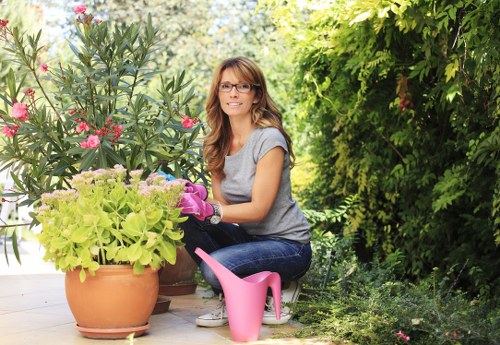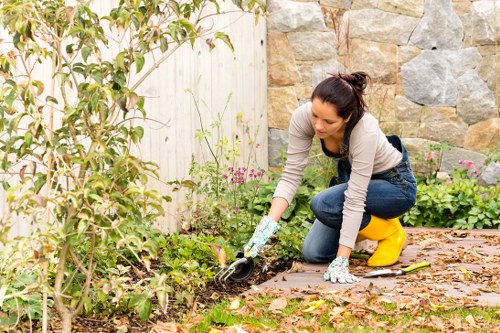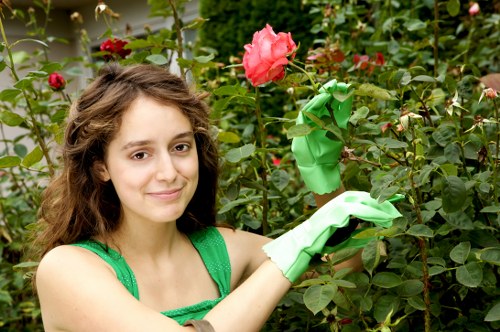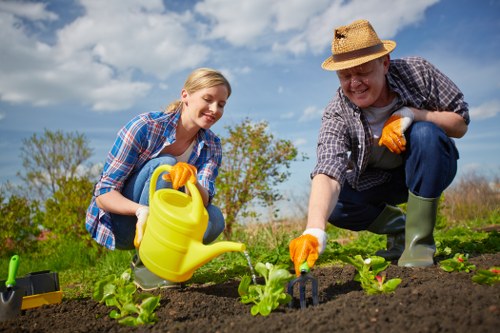Landscape Gardening in Poplar
Introduction to Landscape Gardening in Poplar

Landscape gardening in Poplar offers a unique opportunity to transform outdoor spaces into beautiful, functional, and sustainable environments. Whether you're a seasoned gardener or a beginner, understanding the local climate, soil conditions, and plant varieties is essential for creating a thriving garden.
Poplar's diverse community and vibrant atmosphere make it an ideal location for innovative landscaping projects. From residential gardens to commercial spaces, effective landscape gardening can enhance the aesthetic appeal and value of any property.
In this article, we will explore the key aspects of landscape gardening in Poplar, providing you with the insights and tips needed to design and maintain a stunning garden that reflects your personal style and meets your practical needs.
Understanding Poplar's Climate and Soil

Poplar experiences a temperate climate, characterized by mild winters and warm summers. This climate allows for a wide range of plant species to thrive, but it's crucial to select plants that are well-suited to these conditions.
The soil in Poplar varies from area to area, but generally, it is a mix of clay and loam. Conducting a soil test is recommended to determine the pH levels and nutrient content, ensuring that your garden plants receive the appropriate care.
Key considerations for Poplar's climate and soil include:
- Temperature fluctuations: Choose plants that can withstand the seasonal changes.
- Soil drainage: Ensure proper drainage to prevent waterlogging and root rot.
- Sunlight exposure: Assess the amount of sunlight your garden receives to select suitable plant varieties.
Choosing the Right Plants for Your Poplar Garden

Selecting the right plants is fundamental to successful landscape gardening in Poplar. Opt for native species that are adapted to the local environment, as they require less maintenance and are more resilient against pests and diseases.
Popular plant choices for Poplar gardens include:
- Roses: With their vibrant colors and enchanting fragrance, roses add timeless beauty to any garden.
- Lavender: Known for its soothing scent and attractive blooms, lavender is perfect for creating aromatic gardens.
- Hostas: Ideal for shaded areas, hostas provide lush foliage and a variety of textures.
- Maple Trees: Offering shade and seasonal color changes, maple trees are a staple in many Poplar landscapes.
Additionally, incorporating evergreen plants ensures year-round interest and structure in your garden design.
Designing Your Garden Layout

A well-thought-out garden layout is the foundation of effective landscape gardening in Poplar. Start by assessing the space available and determining the primary functions of your garden, such as relaxation, entertainment, or vegetable cultivation.
Consider the following design principles:
- Balance: Distribute elements evenly to create a harmonious appearance.
- Focal Points: Incorporate features like fountains, sculptures, or specimen plants to draw the eye.
- Pathways: Use paths to guide visitors through the garden and connect different areas.
- Layers: Arrange plants in layers, from groundcovers to tall shrubs and trees, to add depth and dimension.
Utilizing design software or consulting with a landscape architect can help visualize your ideas and refine the layout.
Maintenance and Care Tips

Proper maintenance is essential for keeping your Poplar landscape garden healthy and attractive. Regular care routines ensure that plants thrive and the garden remains free of weeds and pests.
Here are some maintenance tips:
- Watering: Provide adequate water, especially during dry spells, but avoid overwatering to prevent root issues.
- Pruning: Trim plants regularly to promote healthy growth and maintain their shape.
- Weeding: Remove weeds promptly to reduce competition for nutrients and water.
- Mulching: Apply mulch to retain moisture, regulate soil temperature, and suppress weed growth.
- Fertilizing: Use appropriate fertilizers to provide essential nutrients based on your soil test results.
Implementing a seasonal maintenance schedule can help manage tasks efficiently and keep your garden in top condition year-round.
Sustainable Gardening Practices

Embracing sustainable practices in landscape gardening not only benefits the environment but also enhances the longevity and resilience of your garden. Sustainable gardening in Poplar focuses on minimizing resource use and promoting ecological balance.
Key sustainable practices include:
- Rainwater Harvesting: Collect and store rainwater for irrigation to reduce reliance on municipal water supplies.
- Composting: Recycle organic waste into nutrient-rich compost to enrich the soil naturally.
- Native Planting: Use native species that require fewer resources and are better adapted to local conditions.
- Organic Pest Control: Implement natural pest management strategies to protect plants without harmful chemicals.
- Energy-Efficient Lighting: Use solar-powered or LED lights to illuminate garden pathways and features sustainably.
Integrating these practices into your landscape gardening plan can create a more eco-friendly and sustainable outdoor space.
DIY vs. Professional Landscaping Services

Deciding between a DIY approach and hiring professional landscaping services depends on various factors, including budget, time, and personal expertise.
Advantages of DIY Landscaping:
- Cost savings on labor and design services.
- Personal satisfaction in creating and maintaining your garden.
- Flexibility to work at your own pace.
Benefits of Hiring Professionals:
- Access to expert knowledge and experience.
- Professional design and execution of complex projects.
- Time efficiency, allowing you to focus on other tasks.
- Utilization of specialized tools and equipment.
Assess your specific needs and resources to determine the best approach for your landscape gardening project in Poplar.
Enhancing Curb Appeal with Landscape Features

Incorporating distinctive landscape features can significantly enhance the curb appeal of your property in Poplar. Thoughtfully selected elements add character and functionality to your garden space.
Popular landscape features include:
- Water Features: Ponds, waterfalls, and fountains introduce soothing sounds and visual interest.
- Outdoor Lighting: Strategically placed lights highlight architectural elements and provide safety at night.
- Patios and Decks: Create welcoming areas for outdoor gatherings and relaxation.
- Garden Structures: Arbors, pergolas, and trellises add vertical interest and support climbing plants.
- Rock Gardens: Incorporate rocks and stones for a low-maintenance and visually appealing landscape.
Selecting the right features that complement your garden's design and your lifestyle can greatly improve the overall aesthetic and functionality of your outdoor space.
Planting for Seasonal Interest

Designing a garden that offers seasonal interest ensures that your landscape remains vibrant and engaging throughout the year in Poplar.
To achieve this, consider the following:
- Spring: Plant flowering bulbs like tulips and daffodils, and incorporate early-blooming shrubs.
- Summer: Use a mix of perennials and annuals to provide continuous color and texture.
- Autumn: Include plants with striking fall foliage and ornamental seeds.
- Winter: Utilize evergreen plants and shrubs to maintain structure and color during colder months.
By selecting a diverse range of plants that bloom and change with the seasons, your landscape garden will offer year-round beauty and interest.
Incorporating Hardscaping Elements

Hardscaping refers to the non-living components of your garden, such as pathways, walls, and structures. Properly integrated hardscaping elements add functionality and aesthetic appeal to your landscape garden in Poplar.
Key hardscaping elements to consider:
- Paths and Walkways: Create clear and attractive routes for movement through the garden.
- Retaining Walls: Stabilize slopes and add visual interest with stone or brick walls.
- Garden Edging: Define plant beds and separate different areas with edging materials.
- Outdoor Furniture: Incorporate seating and dining areas to enhance usability.
- Fences and Gates: Provide privacy and security while adding structure to the garden layout.
Balancing hardscaping with softscaping—plants and greenery—creates a cohesive and inviting outdoor environment.
Lighting Your Landscape Garden

Effective lighting transforms your landscape garden in Poplar, extending its usability into the evening and highlighting its best features. Proper lighting design enhances safety, security, and ambiance.
Consider the following lighting options:
- Path Lights: Illuminate walkways to guide guests and prevent accidents.
- Spotlights: Highlight focal points like trees, sculptures, or water features.
- Ambient Lighting: Use string lights or lanterns to create a warm and inviting atmosphere.
- Understated Lighting: Integrate subtle lighting beneath decks or along garden borders for a soft glow.
- Solar-Powered Lights: Opt for energy-efficient solar lights to reduce electricity usage.
Strategically placed lighting not only enhances the visual appeal of your garden but also increases its functionality after dark.
Choosing Sustainable Materials

Selecting sustainable materials for your landscape garden in Poplar contributes to environmental conservation and ensures the longevity of your garden features.
Popular sustainable materials include:
- Recycled Stone: Utilize recycled materials for walls and pathways to reduce waste.
- Bamboo: Incorporate bamboo for fencing, structures, and decorative elements due to its rapid growth and renewability.
- Permeable Pavers: Use permeable materials for driveways and walkways to promote water drainage and reduce runoff.
- Composite Decking: Choose composite materials for decks and patios that resist rot and require minimal maintenance.
- Reclaimed Wood: Employ reclaimed wood for garden structures and furniture to add character and reduce deforestation.
Integrating sustainable materials aligns your landscape gardening practices with eco-friendly principles, benefiting both your garden and the planet.
Creating a Wildlife-Friendly Garden

Designing a wildlife-friendly landscape garden in Poplar supports local biodiversity and creates a dynamic ecosystem. By providing habitat and resources, you encourage beneficial wildlife visits to your garden.
Steps to make your garden wildlife-friendly:
- Plant Diversity: Incorporate a variety of plants to attract different species of birds, insects, and small mammals.
- Water Sources: Install birdbaths, fountains, or small ponds to provide drinking and bathing water for wildlife.
- Shelter and Nesting Sites: Create spaces for animals to hide and nest, such as brush piles or nesting boxes.
- Native Plants: Use native vegetation that supports local wildlife and ecosystem health.
- Reduce Pesticide Use: Minimize chemical interventions to protect beneficial insects and animals.
By fostering a habitat that supports wildlife, your landscape garden becomes a vibrant and lively space that contributes to environmental sustainability.
Implementing Seasonal Maintenance

Maintaining a healthy landscape garden in Poplar requires seasonal upkeep to address the changing needs of plants and outdoor spaces throughout the year.
Seasonal maintenance tasks include:
- Spring: Clean up debris, prune dead branches, plant new annuals, and prepare soil for planting.
- Summer: Monitor for pests, provide adequate watering, deadhead flowers, and manage weeds.
- Autumn: Rake leaves, mulch perennials, plant spring bulbs, and prune trees.
- Winter: Protect plants from frost, prune deciduous trees, and plan garden layouts for the upcoming year.
Adhering to a seasonal maintenance schedule ensures that your landscape garden remains healthy, attractive, and resilient against seasonal challenges.
Integrating Edible Plants into Your Landscape

Incorporating edible plants into your landscape garden in Poplar combines beauty with functionality, allowing you to enjoy fresh produce while enhancing the garden's aesthetic appeal.
Ways to integrate edible plants:
- Herb Gardens: Plant herbs like basil, rosemary, and thyme in designated beds or containers for easy access and use.
- Fruit Trees: Include apple, pear, or cherry trees to provide seasonal fruit and shade.
- Vegetable Beds: Allocate space for growing vegetables, utilizing raised beds or vertical gardening techniques.
- Edible Landscaping: Use ornamental plants that also offer edible benefits, such as ornamental kale or edible flowers.
- Greenhouses: Install a greenhouse to extend the growing season and cultivate a wider range of produce.
Combining edible plants with traditional landscaping elements creates a productive and visually appealing garden space that caters to both aesthetic and practical desires.
Final Thoughts on Landscape Gardening in Poplar

Landscape gardening in Poplar is a rewarding endeavor that blends creativity, sustainability, and functionality. By understanding the local climate, selecting appropriate plants, and implementing thoughtful design principles, you can create a garden that not only looks stunning but also supports environmental health and personal well-being.
Whether you choose to embark on this journey as a DIY enthusiast or seek the expertise of professional landscapers, the key to success lies in careful planning, consistent maintenance, and a passion for cultivating beauty in your outdoor spaces.
Ready to transform your outdoor space? Contact us today to start your landscape gardening project in Poplar!
